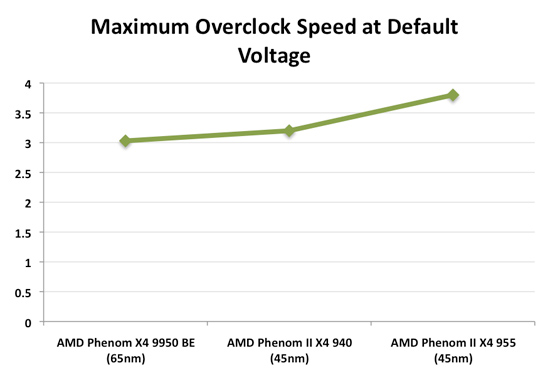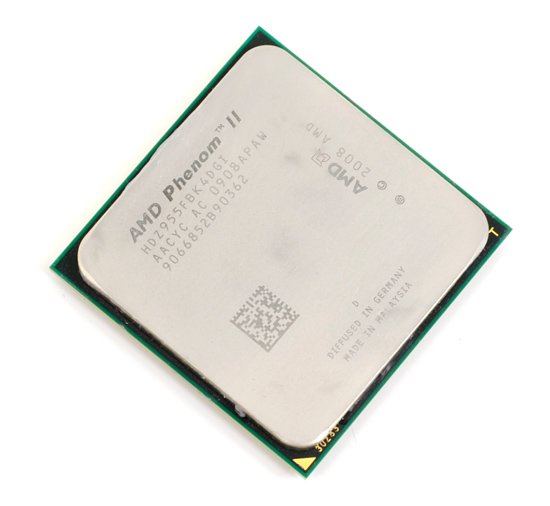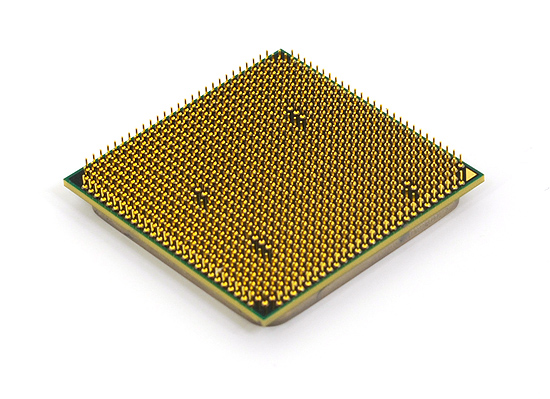AMD's Phenom II X4 955 Black Edition
by Anand Lal Shimpi on April 23, 2009 12:00 AM EST- Posted in
- CPUs
Die size hasn’t changed, clock speeds barely went up, and performance per clock also remained static. But what’s this?

Ah yes, AMD is improving its 45nm manufacturing process and today we have the latest incarnation of AMD’s 45nm silicon.
The first versions of AMD’s 45nm Phenom II couldn’t really go much higher than the final 65nm Phenom without increasing voltage. By comparison, Intel’s Core i7 920 could go from 2.66GHz all the way up to 3.80GHz without so much as a single extra millivolt in our tests.
This new Phenom II however can also hit 3.80GHz without increasing the core voltage. At least that’s what one of our samples did in our testing. Whether it’s 3.8GHz or 3.6GHz, the fact of the matter is that AMD’s 45nm process is improving and that’s what’s behind todays introduction of the Phenom II X4 955. Architecturally the Phenom II hasn't changed; if you're curious about what makes these things tick, please look at our original article on the CPU.


Clocked at 3.2GHz with a 2.0GHz un-core (or North Bridge) frequency, the 955 isn’t that much different from the 940 in terms of clock speed. The two face off in the table below:
| CPU | Clock Speed | un-core Clock (NB Frequency) | Die Size | Transistor Count | TDP | Socket |
| Phenom II X4 955 | 3.2GHz | 2.0GHz | 258 mm2 | 758M | 125W | AM3 or AM2+ |
| Phenom II X4 940 | 3.0GHz | 1.8GHz | 258 mm2 | 758M | 125W | AM2+ |
This is a Socket-AM3 part, meaning it can work in both DDR2 based Socket-AM2+ motherboards and DDR3 based Socket-AM3 motherboards. There’s a huge compatibility caveat about AM2+ support but I’ll address that shortly. The Phenom II X4 955 is also a Black Edition part, meaning it has an unlocked clock multiplier for easy overclocking.

Along with the 955 there’s also a 945 being introduced today. The 945 is identical to the 940 in core clock speed but has a 2.0GHz un-core and is also AM3 compatible.
| Processor | Clock Speed | un-core Clock | L2 Cache | L3 Cache | TDP | Price |
| AMD Phenom II X4 955 BE | 3.2GHz | 2.0GHz | 2MB | 6MB | 125W | $245 |
| AMD Phenom II X4 945 | 3.0GHz | 2.0GHz | 2MB | 6MB | 125W | $225 |
| AMD Phenom II X4 940 BE | 3.0GHz | 1.8GHz | 2MB | 6MB | 125W | $225 |
| AMD Phenom II X4 920 | 2.8GHz | 1.8GHz | 2MB | 6MB | 125W | $195 |
| AMD Phenom II X4 910 | 2.6GHz | 2.0GHz | 2MB | 6MB | 95W | $??? |
| AMD Phenom II X4 810 | 2.6GHz | 2.0GHz | 2MB | 4MB | 95W | $175 |
| AMD Phenom II X4 805 | 2.5GHz | 2.0GHz | 2MB | 4MB | 95W | $??? |
| AMD Phenom II X3 720 BE | 2.8GHz | 2.0GHz | 1.5MB | 6MB | 95W | $145 |
| AMD Phenom II X3 710 | 2.6GHz | 2.0GHz | 1.5MB | 6MB | 95W | $125 |
| AMD Phenom 9950 | 2.6GHz | 2.0GHz | 2MB | 2MB | 140W | $173 |
The prices are pretty attractive; the 955 will sell for $245 (and it already has been) and the 945 will go for $225. That pits the 955 against Intel’s Core 2 Duo Q9550 ($266) and the Core i7-920 ($284), the latter having a much higher motherboard cost of course.
| Processor | Price |
| Intel Core i7-920 (2.66GHz) | $284 |
| Intel Core 2 Quad Q9650 (3.00GHz) | $316 |
| Intel Core 2 Quad Q9550 (2.83GHz) | $266 |
| Intel Core 2 Quad Q9400 (2.66GHz) | $213 |
| Intel Core 2 Quad Q8400 (2.66GHz) | $183 |
| Intel Core 2 Quad Q8300 (2.50GHz) | $183 |
| Intel Core 2 Quad Q8200 (2.33GHz) | $163 |
And you know how I love spoiling surprises so here you have it. Unless you’re running applications that are very well optimized for Intel’s architectures, the Phenom II X4 955 is faster than the Core 2 Quad Q9550. Compared to the Core i7-920, it loses hands down although the chip does come close in some games.
Sorry, I’m not much of a tease :) Now for the rest of the article.










65 Comments
View All Comments
strikeback03 - Thursday, April 23, 2009 - link
Well, the most expensive X58 board is over $400, while the cheapest AM2+ boards are under $50, do you want them to say the range is over $350? I'd guess the thinking behind that statement was that you would pair the most expensive processor AMD sells with a higher-end board - the AMD boards top out at about $190, about where the i7 boards start (ignoring rebates).just4U - Friday, April 24, 2009 - link
It's the minimum entry level into each that I think most people would be curious about. The higher end stuff can really skyrocket the price after all and I am pretty sure it would be filled with features not likely to interest the majority.strikeback03 - Friday, April 24, 2009 - link
Again though, those who are looking to buy the 955 are probably interested in some of the stuff the better boards offer. Considering the performance available form the 720 or 940 at cheaper prices, I am still doubtful how many people would go for the 955 and the cheapest motherboard possible.duploxxx - Thursday, April 23, 2009 - link
arrgghh stupied newegg search engine and no edit on anandtech poststhe msi costs 131, that is still 40$
http://www.newegg.com/Product/Product.aspx?Item=N8...">http://www.newegg.com/Product/Product.aspx?Item=N8...
ssj4Gogeta - Thursday, April 23, 2009 - link
AMD is getting close and that's a good thing as all of us know. Not that I use AMD, but low prices on Intel chips is good.But I think that AMD is soon going to be left behind again when Intel introduces the affordable i5. From what I know the only difference between i7 is that i5 has only 2 channels of RAM and it has the PCIe controller on the package. Surely it won't be too far behind i7 in terms of performance.
Also can someone clarify whether i5 will be using QPI?
duploxxx - Thursday, April 23, 2009 - link
well then you are one of the so many that have an issue about best price/performance and waht about know, all non i7 buyers are better of pricewise with a AMD based system unless you really want to stick with dualcore for no future at all... . On what planet were you living from 2003-2006 when AMD was the better choice of buying instead off Intel.Sagath - Thursday, April 23, 2009 - link
Yes, and No. It uses a QPI derivative called CPI if my memory serves correct.I dont remember where I read this, so I cannot referance you to it. Nor do I know the difference between the two. Sorry.
knutjb - Thursday, April 23, 2009 - link
AMD still has a long way to go but they are improving. I am glad to see them improve since it pressures Intel to lower prices that benefit the majority of us who can't afford Intel's high end. The closer the competition the better for the consumer, we can't afford to see AMD die off as some joke about.Griswold - Thursday, April 23, 2009 - link
"..but as applications and workloads become more threaded the i7 could be a wiser long-term purchase. "I bought my Q6600 in 2007 and for good reasons (then). I made good use of the four cores - but I've been hearing the above quoted sentence sind 2007 and before but it still has not become true and probably wont before quite some time.
Where is this "more threaded" and when will it actually arrive? :P
The situation is such, that I'm definitely going to wait for i5 for the next upgrade and may grab a dualie with hyperthreading, simply because theres only so much I need 4 physical cores for now so it starts to seem like 2 cores plus the two additional logic cores is the more cost efficient and rational way.
An i7 is definitely not going to be my thing - I just dont need 8 logical cores enough to make it worthwhile.
But maybe I can stick to my trusty Q6600 long enough for AMD to serve me the perfect solution, maybe with Bulldozer?
ssj4Gogeta - Thursday, April 23, 2009 - link
Why do you look at the number of cores and decide? Look at the performance numbers and decided.Besides Hyper threading can't deliver performance boost in all applications. So if you're going 2 cores with hyperthreading you may not see as much performance as 4 physical cores in many apps. You need to look at performance numbers for the apps you most use, not the number of cores.